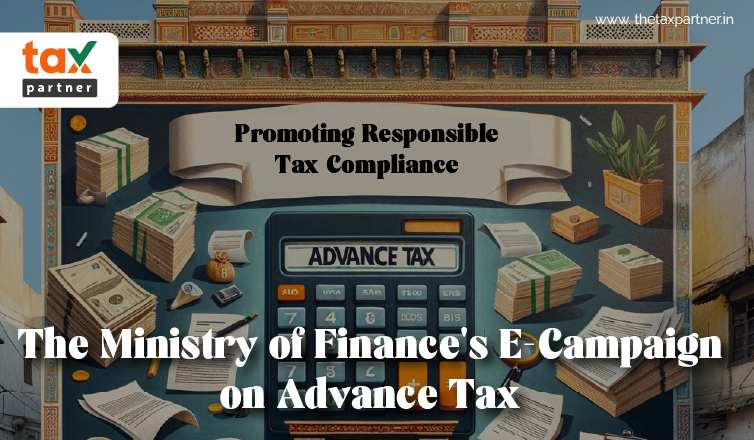Connect with us for all your queries



Author- Tanvi Thapliyal
The e-campaign begun by the Income Tax Department regarding Advance Tax for the Financial Year (F.Y.) 2023-24 has been recently announced by the Central Board of Direct Taxes (CBDT) on 10th march 2024 , which operates under the Ministry of Finance, Government of India. The main objective of this electronic campaign is to promote tax compliance among people and companies whose tax returns do not correspond with their financial activities within the designated timeframe.
The Advance Tax is a tax payment method that necessitates taxpayers to make periodic payments, typically prior to the conclusion of the fiscal year, as opposed to making a single payment at the end of the year. The aforementioned system plays a vital role within the Indian taxation framework, as it facilitates the government's prompt tax collection and guarantees a consistent income stream over the course of the fiscal year.
According to the Advance Tax system, taxpayers are required to make an estimation of their annual income and subsequently make tax payments in periodic installments. The utilisation of this estimation allows for the government to periodically acquire tax revenues, hence supporting the efficient planning and management of the budget. Furthermore, Advance Tax serves as a valuable tool for taxpayers in effectively managing their cash flows by distributing their tax obligations throughout the year.
The initiation of the e-campaign by the Income Tax Department is driven by the need to examine particular financial transactions of individuals and companies in order to guarantee compliance to tax regulations. In today's world, tax authorities possess extensive financial data from diverse sources due to advancements in technology and data analytics. The dataset comprises a range of transactions, including significant investments, property transactions, business dealings, and other significant financial operations.
The examination of these particular financial transactions enables the Income Tax Department to evaluate the accuracy of taxpayers' income reporting and their compliance with tax obligations. Differences between the income reported and the financial transactions can give rise to concerns, suggesting the possibility of tax evasion or non-adherence to regulations. Consequently, the Income Tax Department implements measures such as electronic campaigns to aggressively detect such instances and encourage individuals to address any inconsistencies in their tax payments.
Ensuring compliance with tax laws and regulations. ignoring to comply with this requirement may result in the imposition of penalties, fines, or legal actions by tax authorities.
Precise assessment and timely payment of tax obligations empower individuals and corporations to strategically manage their financial resources.
Making tax payments promptly and accurately decreases the probability of being chosen for tax audits or scrutiny by tax authorities.
Tax revenues are of utmost importance in financing government programmes and initiatives that seek to foster economic growth, facilitate infrastructure development, enhance social welfare, and provide public services, thereby making a significant contribution to national development. Punctual tax payments are vital in promoting the development and growth of the nation.
According to the press release, the primary goals of the e-campaign launched by the Income Tax Department are as follows:
The e-campaign launched by the Income Tax Department operates through electronic communication channels, primarily utilizing email and SMS, to reach out to taxpayers. Here's a detailed explanation of how the e-campaign works:
Communication Methods
Deadline for Paying Advance Tax
Sources of Information
Significance of Annual Information Statement (AIS)
For taxpayers to access details of significant transactions through their e-filing accounts and the Compliance Portal, the following steps need to be followed:
For Taxpayers with E-Filing Accounts
For Individuals or Entities Not Registered on E-Filing Website
The implementation of the e-campaign by the Income Tax Department signifies an important step in improving the quality of taxpayer services and the promotion of voluntary tax compliance. The campaign uses proactive communication channels, including email and SMS, to communicate information to taxpayers regarding significant financial transactions and encourages them to diligently assess their tax obligations with precision. The government's dedication to offering easily accessible and prompt interventions in tax affairs is demonstrated by this programme, which aims to promote transparency and accountability in the tax system. The punctual and precise remittance of tax payments holds significant importance, not alone for individual taxpayers, but also for the nation's efforts in revenue generation and economic advancement. Taxpayers make a responsible contribution to the government's revenue pool by meeting their tax obligations. This revenue is crucial for financing public services, infrastructure development, and social welfare programmes. Hence, the electronic campaign assumes a crucial function in developing a culture of adherence and boosting the nation's economic advancement and well-being.
What is advance tax?
Advance tax refers to the payment of income tax in installments throughout the year, rather than a lump sum payment at the year's end. It's based on the principle of "pay as you earn" and is applicable when the tax liability of an individual or company exceeds ₹10,000 in a financial year.
How to pay advance tax?
Advance tax can be paid online through the Income Tax Department's official website or by using the net banking facility of authorized banks. The process involves filling out the relevant challan (ITNS 280) and selecting the correct assessment year, along with other required details.
How to calculate advance tax?
Advance tax is calculated by estimating the total income for the year, applying the current income tax rates to calculate the tax liability, and then subtracting any tax deducted at source (TDS). The resulting tax liability is then paid in installments as per the due dates provided by the Income Tax Department.
Who is liable to pay advance tax?
Individuals, businesses, and corporations with a tax liability exceeding ₹10,000 in a financial year are required to pay advance tax. This includes salaried individuals, freelancers, businesses, and professionals. However, senior citizens (above 60 years) who do not run a business are exempt from advance tax.
What is advance payment of tax?
Advance payment of tax, or advance tax, involves paying income tax in parts throughout the year, based on estimated earnings, rather than paying the entire amount at the end of the fiscal year. It's designed to help taxpayers manage their tax liability by spreading payments.
How to pay advance income tax online?
Paying advance income tax online involves visiting the Income Tax Department's e-payment portal or using the net banking facility provided by authorized banks. Taxpayers need to fill in the requisite details on Challan 280 and select the correct assessment year for which the advance tax payment is made.
How to calculate advance tax for AY 2023-24?
To calculate advance tax for AY 2023-24, estimate the total income for the financial year 2022-23, calculate the tax liability using the applicable income tax slabs, and deduct any TDS or tax credits available. The resulting net tax liability is payable as advance tax in installments as per ITD guidelines.
What is advance tax in India?
In India, advance tax is a mechanism where taxpayers make payments towards their estimated tax liability in installments throughout the financial year, rather than paying a lump sum amount at the end of the year. It applies to all taxpayers whose tax liability exceeds ₹10,000 in a financial year.
Who should pay advance tax?
Advance tax should be paid by all taxpayers, including salaried individuals, self-employed professionals, businessmen, and companies, whose tax liability for a financial year exceeds ₹10,000. Exceptions include senior citizens who do not have income from business or profession.
Tax Partner is India’s most reliable online business service platform, dedicated to helping you in starting, growing, & flourishing your business with our wide array of expert services at a very affordable cost.